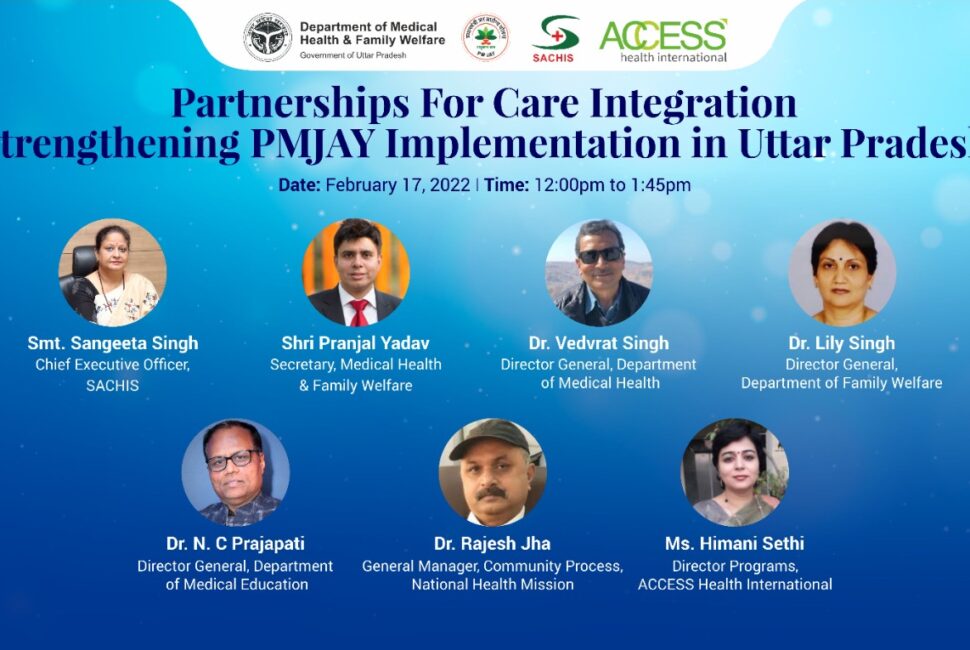Partnerships for Care Integration to Ensure Continuum of Care Across Health Systems in Uttar Pradesh

In Uttar Pradesh, the Pradhan Mantri Jan Arogya Yojana (PM-JAY) is increasing focus on how to leverage public and private health systems, programs, and schemes, to offer a better experience to the beneficiary.
Since its implementation in September 2018, the Ayushman Bharat Pradhan Mantri Jan Arogya Yojana (PM-JAY) has gathered strength in moving towards the goal of providing universal health coverage in Uttar Pradesh. After the first phase of implementation, there is an increasing focus on how to leverage the public and private health systems, programs, and schemes to offer a better experience for the PM-JAY beneficiary.
The State Agency for Comprehensive Health & Integrated Services (SACHIS) which implements the scheme in Uttar Pradesh, organized a discussion in partnership with the Department of Health and Family Welfare, Department of Medical Education, and National Health Mission, to identify possible opportunities in improving coordination and implementation.
The discussion facilitated by ACCESS Health was chaired by Mr. Pranjal Yadav, Secretary, Medical Health and Family Welfare with participation from Mrs. Sangeeta Singh, CEO, SACHIS, Dr. Vedvrat Singh, Director General (DG), Department of Medical Health, Dr. Lily Singh, DG, Department of Family Welfare, Dr N.C. Prajapati, DG, Department of Medical Education, and Dr. Rajesh Jha, General Manager, Community Process, National Health Mission.
The discussion acknowledged that participation of the public sector hospitals and institutions in PM-JAY can improve access to care, however, increasing the quality and patient experience is of critical importance. At present, there is little motivation for the beneficiary to use the PM-JAY cover in a public hospital as they are entitled to free care in these facilities. Also, there is a preference for seeking healthcare in private hospitals. Hence the need of the hour is to increase the value proposition of care through an integrated, beneficiary-centric system.
Insights and Opportunities
At the community level, integrated beneficiary support through the Health and Wellness Centres (HCWs) for beneficiary identification, telemedicine for specialist care, referrals to higher facilities for diagnostic and hospital care, transport, and post-hospital follow-up in the community. Specifically for institutional deliveries of high-risk pregnancies among PM-JAY beneficiaries’ greater coordination with PM-JAY can ensure that if women need a Cesarean – section service, these could be referred to private empanelled hospitals. The Health and Wellness Centres have these provisions and the discussion clearly highlighted the intent and feasibility to work on integrating the pathway which can connect these services for PM-JAY beneficiaries.
At public hospitals, besides the availability of infrastructure and human resources, there is a need for better information for beneficiaries to navigate the system to access care in facilities and post-treatment care. Equally important is streamlining the supply of drugs and diagnostics which remains a challenge through linkages with public systems such as the Jan Aushadhi Kendra, Amrit Pharmacy, or even private vendors to ensure supply. In larger institutions such as medical colleges with multiple specialties and large volumes of people, there is a need for dedicated help desks, dedicated wards (infrastructure) to provide information, access support, and better services. There was consensus and agreement that this can be done through engagement and information sharing between PM-JAY and other departments.
About PM-JAY in Uttar Pradesh: SACHIS, provides secondary and tertiary care to 31 percent of the state population. It has established a wide network of over 2500 hospitals in the state, 40 percent of these are public hospitals and plays a critical role in the supply of PM-JAY services, especially in areas where there is a lack of private providers and hospitals. ACCESS Health will continue to support in creating the care linkages in the state.

